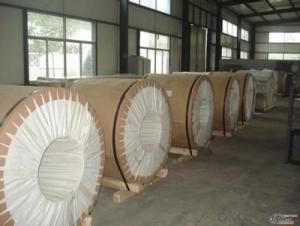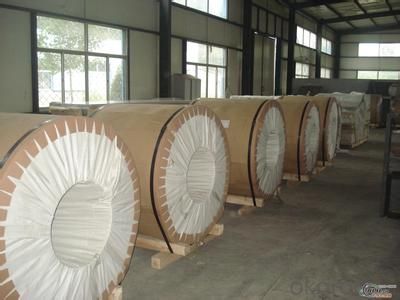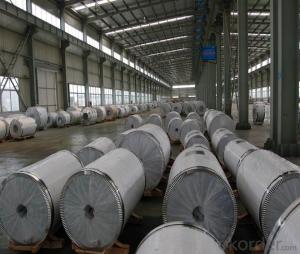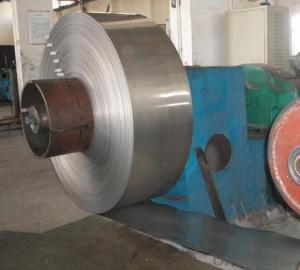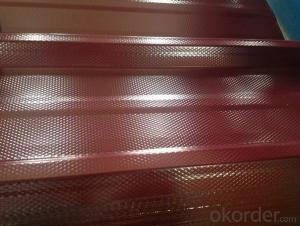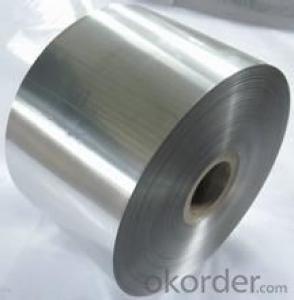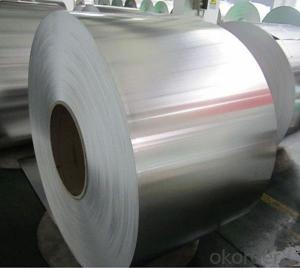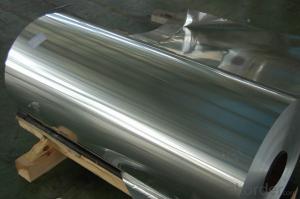Wholesale Aluminum Coil Roll - Supply Aluminum Coil Products Supplier in China
- Loading Port:
- China main port
- Payment Terms:
- TT or LC
- Min Order Qty:
- 3 m.t.
- Supply Capability:
- 17 m.t./month
OKorder Service Pledge
OKorder Financial Service
You Might Also Like
Aluminium is a relatively soft,durable, lightweight, ductile and malleablemetalwith appearance ranging from silvery to dull gray, depending on the surfaceroughness. It is nonmagnetic and does not easily ignite. A fresh film ofaluminium serves as a good reflector (approximately 92%) of visible light and an excellent reflector (asmuch as 98%) of medium and far infrared radiation. The yield strengthof pure aluminium is 7–11 MPa, while aluminium alloys have yield strengths ranging from200 MPa to 600 MPa. Aluminium has about one-third the density and stiffness of steel.It is easily machined, cast, drawn and extruded.
Aluminium alloys (or aluminum alloys; see spellingdifferences) are alloysin which aluminium(Al) is the predominant metal. The typical alloying elements are copper, magnesium,manganese,silicon,tin and zinc. There are twoprincipal classifications, namely casting alloys and wrought alloys, both of which are furthersubdivided into the categories heat-treatableand non-heat-treatable. About 85% of aluminium is used for wrought products,for example rolled plate, foils and extrusions.Cast aluminium alloys yield cost-effective products due to the low meltingpoint, although they generally have lower tensile strengthsthan wrought alloys. The most important cast aluminium alloy system is Al–Si,where the high levels of silicon (4.0–13%) contribute to give good castingcharacteristics. Aluminium alloys are widely used in engineering structures andcomponents where light weight or corrosion resistance is required
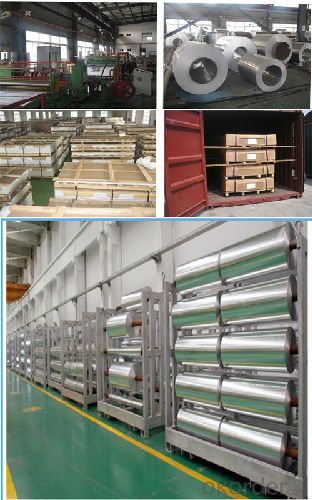
Features:
1. Excellent quality of products
2. Quick delivery
3. Best service to clients
4. BV,SGS avalible
5. No buckle o waveness
6. Tension leveling
7. Certificate of Origin
8. Form A,E
Packaging Detail: Carton ,Wooden pallet with plastic protection packing,standard seaworthy packing or as your request.
ProductionCapacity:
AnnualProduction capacity of 600,000 tons.
Products areexported to United States, Canada, U.A.E, Brazil, Mexico,Thailand, Vietnam,Nigeria etc, over 100 countries andregions all over the world.
Coveredfactories with full production line
CNBM aluminumproduction base is comprised of 18 aluminumannealers, 10 coil and foilmills, 4 continuous production lines, 2hot rolling production line and 3prepainted lines.
FAQ:
1. What is the form of payment?
Normally 30% TT, L/C
2. Type of quotation?
FOB, CFR, CIF
3. Port of loading?
Shanghai port
4. Delivery time?
30 day after client’s deposit
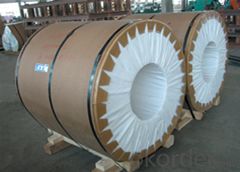
Colored aluminum sheets advantages:
The colored aluminum sheet has the advantages of both aluminum and the organic material, having both high mechanical strength of the aluminum plate, good toughness, easy processing performance advantages, but also has an organic polymer coating material is good coloring, decorative, corrosion resistance, can easily punching, bending, deep drawing, welding and other processing, products made of practical, decorative, easy processing and durable. Colored aluminum is widely used in industrial plants, railway stations, airports, stadiums, commercial buildings, homes and other buildings and manufacturing all kinds of home appliances and so on.
Colored aluminum sheet has been widely used in foreign countries, and with the continued rapid growth of China's economic construction over the past decade, Colored aluminum sheet applications and growing demand. Because of its widespread use, easy processing, long service life, light weight (specific gravity is 1/3 of iron), low unit cost, anti-fouling coatings cleaning, beautiful rich color, green and so gradually become Colored aluminum sheet industry the future direction of the market demand for larger.
- Q: Can aluminum coils be used for gutter systems?
- Yes, aluminum coils can be used for gutter systems. Aluminum is a popular choice for gutters due to its lightweight nature, durability, and resistance to rust and corrosion. It is also easy to shape and install, making it a suitable material for gutter systems.
- Q: What is the typical heat transfer coefficient for aluminum coils?
- The heat transfer coefficient for aluminum coils can vary depending on several factors, including the application, coil geometry, and surrounding conditions. Generally, aluminum has high thermal conductivity, which enables efficient heat conduction. In forced convection applications, where heat is transferred using a fluid like air or water, the heat transfer coefficient for aluminum coils can range from 10 to 100 W/m^2K. This range is influenced by factors such as flow rate, velocity, and temperature difference between the coil and the fluid. In natural convection scenarios, where heat transfer occurs due to the buoyancy-driven flow of air, the heat transfer coefficient for aluminum coils is typically lower, ranging from 5 to 25 W/m^2K. This is because the movement of air is slower and the heat transfer effectiveness is reduced compared to forced convection. It's important to note that these values are general guidelines and can vary significantly depending on specific design considerations, material properties, and operating conditions. Therefore, it is recommended to consult specific heat transfer data or conduct detailed experiments or simulations to determine the precise heat transfer coefficient for a given aluminum coil application.
- Q: My mom was being an idiot and used the steel spatula to scrape the cookies off an aluminum cookie sheet. Now there are small bits of aluminum on the bottom of the cookies. I just ate a few of them (5) before i noticed it, should I be worried?
- If it's only a little bit then it will just not be digested and pass through your body and come out your rear end. It's fine, as long as you don't swallow something like a ball-bearing.
- Q: I have a 94 Gt Mustang that has had a little work done to it so far. The boy I bought it from had an aftermarket cam put in it, had the heads ported and polished. He also had the heads shaved a little. My question is.........Would having aluminum heads with roller rocker arms installed help it enough to justify doing it. If it would, how Much would it help? I am not exactly sure how much life and duration my cam is running, but it idle pretty rough. I believe my compression is about 9.5 to 1.
- Good aftermarket heads will often out-flow ported factory heads right out of the box. They often have better valvesprings, retainers, valves, etc. The valvetrain is often set up to use whatever cam you specify. You can also get different combustion chamber sizes to change the compression ratio. The rule of thumb is to bump your compression ratio up 1/2 point to 1 point (9.5 to 10.5)when changing to alumium heads for a given engine setup. Aluminum sucks more heat out of the chamber, which requires a compression increase to compensate. But it isnt as easy as plopping a set of heads on. You need to carefully determine what valvetrain parts to use on the heads, what chamber size to run, will all accessories and manifolds bolt up, intake runner size, port flow data... etc. Typically its best to call the tech line of the head mfg and have a long talk with the tech engineering dude. Choosing the proper setup is the differance between a really fast car and one that can be outrun by a fat kid on a tricycle..
- Q: We are shopping for a new LQ trailer. We are looking at several different brands and noticed that some have aluminum skin on an aluminum frame, and others have aluminum skin on a steel frame. Other than the obvious differences in weight and cost, what are other benefits/disadvantages of each? Thanks
- I swear by an all aluminum trailer! Aluminum over steel next, and I hope I never own another steel trailer! I have had trailers for, lets see, 40 years now, and just bought my first aluminum one about 6 years ago. It is 14 years old and except for a few bumps that WE put in it (the same amount of bump would have dented a steel trailer too) it is in GREAT shape. A 10+ year old steel trailer shows a LOT of wear, and has to be sanded and painted often.
- Q: Can aluminum coils be used for electrical applications?
- Yes, aluminum coils can be used for electrical applications. Aluminum is a highly conductive material and is commonly used in various electrical applications such as transformers, motors, and generators. It offers advantages such as lightweight, good thermal conductivity, and cost-effectiveness, making it a suitable choice for electrical coils.
- Q: What are the different coil handling methods for aluminum coils?
- There are several coil handling methods for aluminum coils, including manual handling, fork truck handling, coil grabs, and coil tongs. Manual handling involves physically lifting and moving the coils by hand, while fork truck handling utilizes a forklift to transport and position the coils. Coil grabs and coil tongs are specialized tools that can be attached to lifting equipment to securely grip and lift the coils. These methods ensure safe and efficient handling of aluminum coils in various industrial settings.
- Q: Can aluminum coils be used for heat exchangers?
- Indeed, heat exchangers can make use of aluminum coils. Aluminum has gained popularity as a favored option for heat exchangers owing to its exceptional thermal conductivity, light weight, and resistance to corrosion. These coils usually find application in scenarios where heat transfer is necessary, such as HVAC systems, refrigeration units, and automotive radiators. Aluminum's high thermal conductivity enables efficient heat transfer, while its corrosion resistance guarantees durability and an extended lifespan for the heat exchanger. Moreover, aluminum coils can be effortlessly molded into different shapes and sizes, thereby showcasing their versatility for various heat exchanger designs.
- Q: How many 1220mm*2440mm aluminum sheets can one-ton aluminum coil be sliced to? Thank you.
- You should know the thickness of aluminum sheet first, and then calculate the weight of aluminum sheet of this specification, and finally use 1T divide the weight.
- Q: Are aluminum coils suitable for insulation purposes?
- No, aluminum coils are not suitable for insulation purposes.
Send your message to us
Wholesale Aluminum Coil Roll - Supply Aluminum Coil Products Supplier in China
- Loading Port:
- China main port
- Payment Terms:
- TT or LC
- Min Order Qty:
- 3 m.t.
- Supply Capability:
- 17 m.t./month
OKorder Service Pledge
OKorder Financial Service
Similar products
Hot products
Hot Searches
Related keywords

